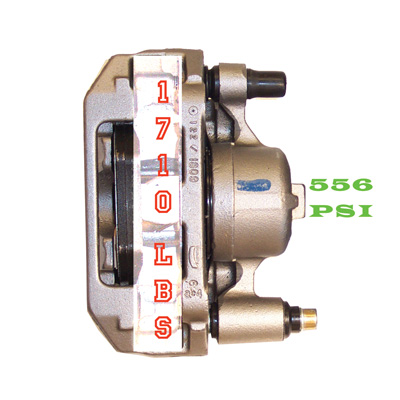
If the calipers are a single piston floating design with a two-inch diameter pistons (piston surface area = pπR2 x 2), we just multiply pistons surface area by 556 psi and surface area and we get a 3,419 lbs. of clamping force at both front calipers!
In our theoretical example above, we are ignoring some real world factors that influence the amount of clamping force. The reality of it is that not all of the 556 psi makes it to the caliper and some of the force is wasted flexing the caliper and compressing the brake pads.
While the brake fluid is traveling from the master cylinder to the calipers, it is pushing on the walls of the brake lines and hoses. This means that some of the pressure or pedal effort is lost. This is why engineers try to keep the amount of flexible hose to a minimum. Also, this is why race cars use braided flexible like to reduce compliance.
Even if all of the pressure makes it to the caliper piston, some of the generated force is lost as the caliper flexes. This flexing can occur at the bridge or mounting points. Most floating caliper designs can have more flex. Opposed piston designs are typically stiffer. But, if the input pressure and piston area is the same for both designs, the calipers will generate the same theoretical forces.
If you try to improve a system by changing to larger calipers with more piston surface area or change the diameter of the master cylinder, you are upsetting the balance.
One of the advantage of four, six or even eight piston calipers is the ability to generate the force more evenly over a larger backing plate.
Another factor in the system is the brake pad and how it acts under the force. If the backing plate flexes, braking force is lost as the friction area flexes and changes.
Inexpensive brake pads will often have thinner backing plates to save on steel. This is leading reason why they can cause a soft or low pedal. It gets even worse if the manufacturer is putting large holes in the backing plate for molding or riveting. Some mechanical attachment designs can eliminate these holes. Another benefit to having a ridged backing plate is less brake noise because the friction surface is more stable and consistent.
The clamping forces are used to generate friction that produces torque to stop the vehicle. This is where “coefficient of friction” comes into play. Basically, the coefficient of friction is calculated by dividing the force required to slide an object over a surface by the weight of the object. For example, if it takes 100 pounds of force to slide a 100-pound brake pad over a rotor, the coefficient of friction between the two materials is 1.0.
Clamping forces and the coefficient of friction are on one side of the equation and brake torque is on the other side. If you increase either variable, you are changing the amount of torque the system can generate.
In essence, engineers balance coefficient of friction with piston and master cylinder sizes to give the vehicle the right amount of stopping force and pedal feel. If you increase or decrease the coefficient of friction, you might be upsetting the balance.














